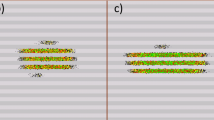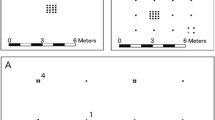Abstract
We studied the effects of landscape structure on species with resource nutritional partition between the immature and adult stages by investigating how food quality and spatial structure of a landscape may affect the invasion and colonization of the insect pest, Diabrotica speciosa. To this end, we formulated two bidimensional stochastic cellular automata, one for the insect immature stage and the other for the adult stage. The automata are coupled by adult oviposition and emergence. Further, each automata site has a specific culture type, which can affect differently the fitness attributes of immatures and adults, such as mortality, development and oviposition rates. We derived the mean-field approximation for these automata model, from which we obtained conditions for insect invasion. We ran numerical simulations using entomological parameters obtained from laboratory experiments (using bean, soybean, potato, and corn crops), and we compared the results of the automata with the ones given by the mean-field approximation. Finally, using artificially generated landscapes, we discussed how the structured heterogeneous landscape can affect dispersal and establishment of insect populations.






Similar content being viewed by others
References
Allen JSL (2007) An introduction to mathematical biology. Pearson Prentice Hall, New Jersey, USA
Ávila CJ, Parra JRP (2002) Desenvolvimento de Diabrotica speciosa (Germar) (Coleoptera: Chrysomelidae) em diferentes hospedeiros. Ciência Rural 32:739–745
Ávila CJ, Parra JRP (2003) Leaf consumption by Diabrotica speciosa (Coleoptra:Chrysomelidae) adults on different host plantes. Sci Agric 60(4):789–792
Bates SL, Zhao JZ, Roush RT, Shelton AM (2005) Insect resistance management in GM crops: past, present and future. Nat. Biotechnol. 23:57–62
Bianchi FJJA, Booij CJH, Tscharntke T (2006) Sustainable pest regulation in agricultural landscapes: a review on landscape composition, biodiversity and natural pest control. Proc R Soc B Biol Sci 273:1715–1727
Caswell H, Etter R (1999) Cellular automaton model for competition in patchy environments: facilitation, inhibition, and tolerance. Bull Math Biol 61:625–649
Chaplin-Kramer R, Kremen C (2012) Pest control experiments show benefits of complexity at landscape and local scales. Ecol Appl 22:1936–1948
Collinge SK, Palmer TM (2002) The influences of patch shape and boundary contrast on insect response to fragmentation in California grasslands. Landsc Ecol 17:647–656
Dover J, Settele J (2009) The influences of landscape structure on butterfly distribution and movement: a review. J Insect Conserv 13:3–27
Elliott NC, Kieckhefer RW, Lee JH, French BW (1998) Influence of within-field and landscape factors on aphid predator populations in wheat. Landsc Ecol 14:239–252
Fabre F, Rousseau E, Mailleret L, Moury B (2012) Durable strategies to deploy plant resistance in agricultural landscapes. New Phytol 193:1064–1075
Fahrig L, Merriam G (1994) Conservation of fragmented populations. Conserv Biol 8(1):50–59
Fahrig L, Baudry J, Brotons L, Burel FG, Crist TO, Fuller RJ, Siramo C, Siriwardema GM, Martin JL (2011) Functional landscape heterogeneity and animal biodiversity in agricultural landscapes. Ecol Lett 14:101–112
Gmez-Virus S, Jansson M, Ekbom B (2012) The ecology and utility of local and landscape scale effects in pest management. In: Gurr GM, Vratten SD, Snyder WE, Read DMY (eds) Biodiversity and insect pests: key issues for sustainable management. Wiley, New York, pp 106–120
Gardiner MM, Landis DA, Gratton C, Difonzo CD, Neal MO, Chacon JM, Wayo MT, Schmidt NP, Mueller EE, Heimpel GE (2009) Landscape diversity enhances biological control of an introduced crop pest in the north-central USA. Ecol Appl 19(1):143–154
Gilioli G, Bodini A, Baumgartner J (2013) Metapopulation modelling and area-wide pest management strategies evaluation. An application to the Pine processionary moth. Ecol Modell 260:1–10
Glaum PR, Ives AR, Andow DA (2011) Contamination and management of resistance evolution to high-dose transgenic insecticidal crops. Theor Ecol 5:195–209
Goddard MA, Dougill AJ, Benton TG (2010) Scaling up from gardens: biodiversity conservation in urban environments. Trends Ecol Evol 25(2):90–98
Gripenberg S, Morrien E, Cudmore A, Salminen J, Roslin T (2007) Resource selection by female moths in a heterogenous environment: what is a poor girl to do? J Anim Ecol 76:854–865
Head GP, Greenplate J (2012) The design and implementation of insect resistance management programs for Bt crops. GM Crops Food: Biotechnol Agric Food Chain 3(3):1–10
Hiebeler D (2000) Populations on fragmented landscapes with spatially structured heterogeneities: landscape generation and local dispersal. Ecology 81(6):1629–1641
Janz N (2005) The relationship between habitat selection and preference for adult and larval food resources in the polyphagous butterfly Vanessa cardui (Lepidoptera: Nymphalidae). J Insect Behav 18:767–780
Macfadyen S, Gibson RH, Symondson WOC, Memmott J (2011) Landscape structure influences modularity patterns in farm food webs: consequences for pest control. Ecol Appl 21(2):516–524
Marino PC, Landis DA (1996) Effect of landscape structure on parasitoid diversity and parasitism in agroecosystems. Ecol Appl 6:276–284
Mayhew PJ (1997) Adaptive patterns of host-plant selection by phytophagous insects. Oikos 79:417–428
Mayhew PJ (2001) Herbivore host choice and optimal bad motherhood. Trends Ecol Evol 16:165–167
Mayse M (1893) Culture control in crop fields: a habitat management technique. Environ Manag 7(1):15–22
Panizzi AR, Parra JRP (2012) Insect bioecology and nutrition for integrated pest management. CRC Press, Boca Raton 732p
Polis GA, Anderson WB, Holt RD (1997) Toward an integration of landscape and food web ecology: the dynamics of spatially subsidized food webs. Ann Rev Ecol Syst 28(1):289–316
Ricci B, Franck P, Toubon JF, Bouvier JC, Sauphanor B, Lavigne C (2009) The influence of landscape on insect pest dynamics: a case study in southeastern France. Landsc Ecol 24:337–349
Ruiz MA, Lugo AE (2012) Landscape effects on structure and species composition of tabonuco forests in Puerto Rico:implications for conservation. For Ecol Manag 266:138–147
Rusch A, Valantin-Morison M, Sarthou JP, Rogeer-Estrade J (2013) Effect of crop management and landscape context on insect populations and crop damage. Agric Ecosyst Environ 166:118–125
Schmidt MH, Tscharntke T (2005) Landscape context of sheetweb spider (Araneae: Linyphiidae) abundance in cereal fields. J Biogeogr 32(3):467–473
Scheirs J, De Bruyn L (2002) Integrating optimal foraging and optimal oviposition theory in plant–insect research. Oikos 96:187–191
Thies C, Tscharntke T (1999) Landscape structure and biological control in agroecosystems. Science 285:893–895
Thompson JN (1988) Evolutionary ecology of the relationship between oviposition preference and performance of offspring in phytophagous insects. Entomologia Experimentalis et Applicata 47:3–14
Topping CJ, Sunderland KD (1994) A spatial population dynamics model for Lepthyphantes tenuis (Araneae:Linyphiidae) with some simulations of the spatial and temporal effects of farming operations and land-use. Agric Ecosyst Environ 48(3):203–217
Walsh GC (2003) Host range and reproductive traits of Diabrotica speciosa (Germar) and Diabritica viridula (F.) (Coleoptera: Chrysomelidae), two species of South American pest rootworms, with notes on other species fo diabroticina. Environ Entomol 32(2):276–285
Wiens JA (2009) Landscape ecology as a foundation for sustainable conservation. Landsc Ecol 24:1053–1065
Woltz JM, Isaacs R, Landis DA (2012) Landscape structure and habitat management differentially influence insect natural enemies in an agricultural landscape. Agric Ecosyst Environ 152:40–49
Acknowledgments
L. E. acknowledges support from project No IN112713, PAPIIT-UNAM. C.P.F acknowledges support from project FAPESP 2013/03954-5 and 2013/24140-6. WACG has also been partially supported by CNPq. This investigation was supported by Grants from FAPESP 2012/00254-0 and CNPq 483567/2012-4.
Author information
Authors and Affiliations
Corresponding author
Appendix: Stability of the Equilibria \(P_0\) and \(P_1\)
Appendix: Stability of the Equilibria \(P_0\) and \(P_1\)
The stability of an equilibrium \(\bar{X}\) of the first-order system of difference equations, \(\bar{X}_{n+1} = F(\bar{X}_n),\) is determined by the eigenvalues of the derivative matrix, \(J(\bar{X}),\) of \(F\) evaluated at \(\bar{X}\). If all the eigenvalues, \(\lambda _i,\) satisfy \(|\lambda _i| < 1\), so that the spectral ratio \(r(J) <1\), then \(\bar{X}\) is locally asymptotically stable (Allen 2007). For system (1) the derivative \(J\) is given by
which evaluated in the trivial equilibrium \(P_0\), adopts the form
The eigenvalues \(\lambda _1, \lambda _2\) satisfy the polynomial
with
For a two-dimensional system, the condition
assures that \(\lambda _1\) and \(\lambda _2\) have norm less than one, and therefore the local stability of the equilibrium point (Allen 2007).
Since \(\sigma + \mu <1\), and \(\gamma <1\), it is easily verified that \(a_1\), and \(a_2\) satisfy
From these expressions, it follows that inequality (14) holds if and only if \(R_0 <1\), and therefore \(P_0\) is asymptotically stable for \(R_0 <1\).
Next, we analyze the stability of \(P_1\). Substituting their coordinates, and replacing \(25\phi \) by \(\displaystyle {\gamma (\sigma + \mu )\over \sigma } R_0\), \(a_1=|-\mathrm{Trace}|\), and \(a_2= \mathrm{Determinant}\) of \(J(P_1)\) become
For \(R_0 =1\), the variables \(a_1=2-\sigma -\mu -\gamma \), and \(a_2 = 2-\gamma \), which implies that the stability conditions (14) are fulfilled. By continuity, it follows that they are still valid for values of \(R_0 >1\) in a neighborhood of \(R_0=1\). But since \(a_1\) increases without bound when \(R_0 \rightarrow \infty \), there must be a value \(R_0^*\) such that \(a_1 \ge 2,\) and the stability conditions no longer hold for \(R_0 > R_0^*\), therefore \(P_1\) becomes unstable, and more complicated dynamics arise.
Rights and permissions
About this article
Cite this article
Ferreira, C.P., Esteva, L., Godoy, W.A.C. et al. Landscape Diversity Influences Dispersal and Establishment of Pest with Complex Nutritional Ecology. Bull Math Biol 76, 1747–1761 (2014). https://doi.org/10.1007/s11538-014-9975-1
Received:
Accepted:
Published:
Issue Date:
DOI: https://doi.org/10.1007/s11538-014-9975-1




